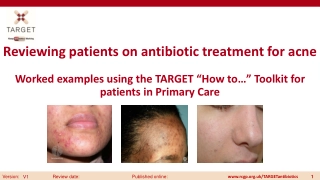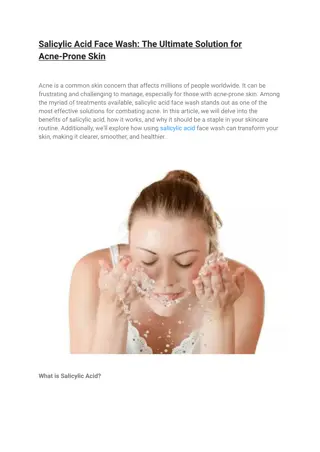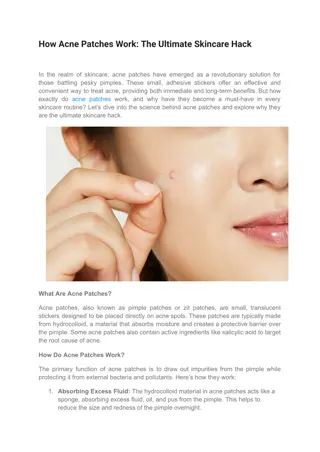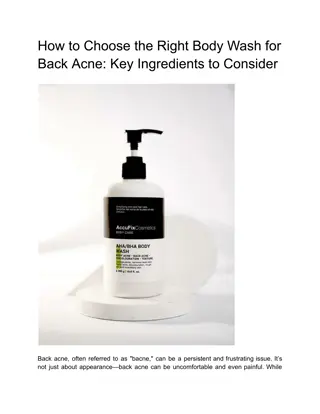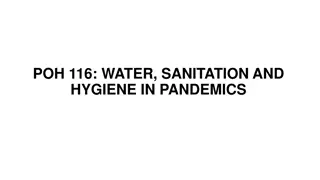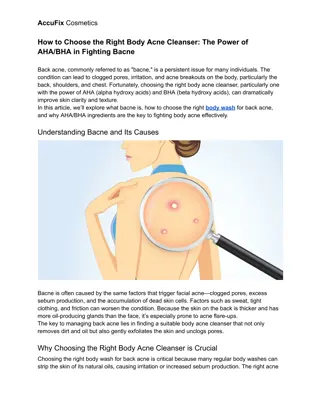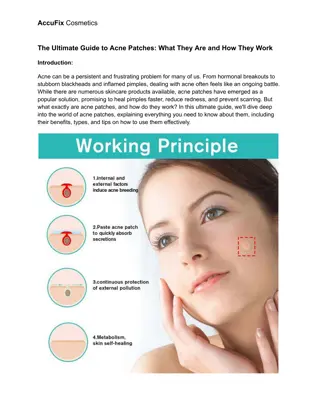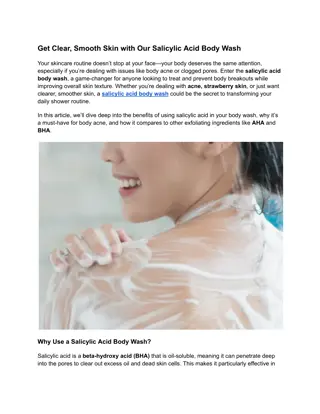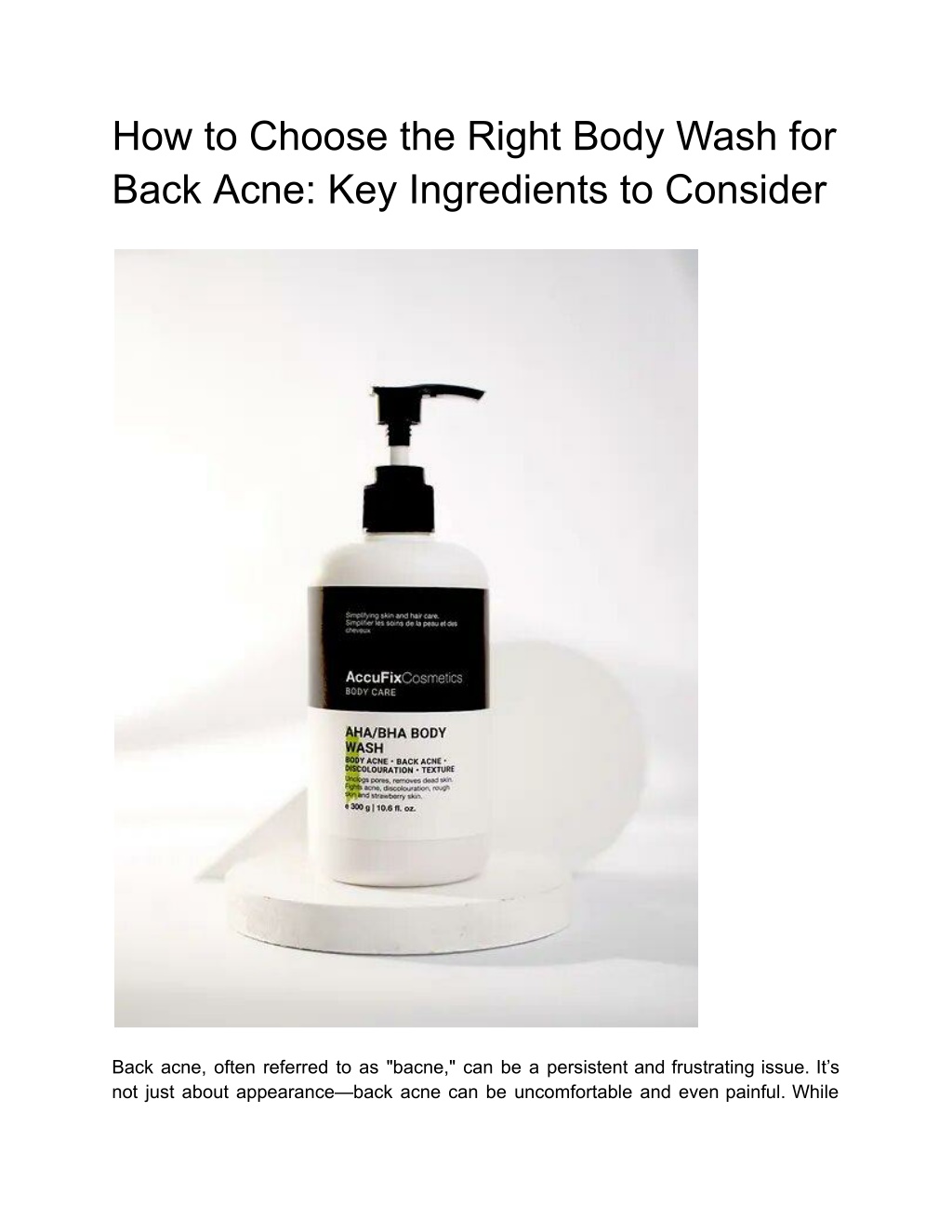
How to Choose the Right Body Wash for Back Acne_ Key Ingredients to Consider
How to choose the right body wash for Back Acne
Download Presentation

Please find below an Image/Link to download the presentation.
The content on the website is provided AS IS for your information and personal use only. It may not be sold, licensed, or shared on other websites without obtaining consent from the author. Download presentation by click this link. If you encounter any issues during the download, it is possible that the publisher has removed the file from their server.
E N D
Presentation Transcript
How to Choose the Right Body Wash for Back Acne: Key Ingredients to Consider Back acne, often referred to as "bacne," can be a persistent and frustrating issue. It s not just about appearance back acne can be uncomfortable and even painful. While
there are many factors that contribute to bacne, one of the most effective ways to manage and treat it is by using the right body wash. But with so many products on the market, how do you choose the best one? This guide will walk you through the key ingredients to look for in a body wash to effectively combat back acne. Understanding the Causes of Back Acne Before diving into the ingredients, it s essential to understand what causes back acne. Similar to facial acne, back acne is primarily caused by clogged pores, excess oil production, bacteria, and inflammation. Sweat, friction from clothing, and even hair products can exacerbate the condition. Therefore, selecting a body wash that targets these underlying causes is crucial for managing and preventing breakouts. Key Ingredients to Look For in a Body Wash for Back Acne Salicylic Acid: The Exfoliating Powerhouse Salicylic acid is a beta-hydroxy acid (BHA) that is widely recognized for its acne-fighting properties. It works by penetrating deep into the pores to exfoliate from within, helping to dissolve the oil and dead skin cells that can clog pores and lead to acne. Why it works: Salicylic acid is oil-soluble, which means it can effectively reach into the pores and clear out the blockages that cause acne. It also has anti-inflammatory properties, which help reduce redness and swelling associated with acne. How to use: Look for a body wash with 1-2% salicylic acid concentration. Use it regularly, but start slowly to see how your skin reacts, as overuse can sometimes lead to dryness. Benzoyl Peroxide: The Bacteria Buster Benzoyl peroxide is another powerful ingredient commonly found in acne treatments. It works by killing the bacteria (Propionibacterium acnes) that contribute to acne formation. Additionally, it helps to reduce excess oil and exfoliate dead skin cells. Why it works: Benzoyl peroxide not only targets acne-causing bacteria but also helps in preventing future breakouts by keeping the pores clear. How to use: For back acne, a body wash with 2.5% to 5% benzoyl peroxide is typically effective. Be mindful that it can bleach fabrics, so rinse thoroughly and use white towels and clothing after use.
Tea Tree Oil: The Natural Antiseptic For those looking for a more natural alternative, tea tree oil is a great option. This essential oil has natural antibacterial and anti-inflammatory properties, making it effective in treating mild to moderate acne. Why it works: Tea tree oil can reduce the bacteria that cause acne and help soothe irritated skin. It s also less likely to cause dryness compared to some stronger chemical treatments. How to use: Choose a body wash that includes tea tree oil as a key ingredient, or add a few drops of pure tea tree oil to your regular body wash. Be cautious if you have sensitive skin, as it can cause irritation in some individuals. Glycolic Acid: The Exfoliating Agent Glycolic acid is an alpha-hydroxy acid (AHA) that helps exfoliate the surface of the skin, removing dead skin cells that can clog pores and lead to acne. It also promotes cell turnover, which can improve skin texture and reduce the appearance of acne scars. Why it works: Glycolic acid is water-soluble and works on the surface of the skin to slough off dead skin cells, making it ideal for preventing clogged pores and treating acne. How to use: Look for a body wash with glycolic acid for regular exfoliation. It s particularly beneficial if you also want to improve skin tone and texture on your back. Sulfur: The Oil Absorber Sulfur has been used in acne treatments for decades due to its ability to absorb excess oil and help exfoliate the skin. It also has antibacterial properties, making it effective against acne. Why it works: Sulfur helps dry out surface-level blemishes while also reducing oiliness, making it a good option for those with oily, acne-prone skin. How to use: Choose a sulfur-based body wash if you have particularly oily skin or if other treatments haven t worked. Be aware that sulfur has a distinct smell, which might be a consideration for some users.
Alpha-Hydroxy Acids (AHAs): Gentle Exfoliation In addition to glycolic acid, other AHAs like lactic acid can also be beneficial for treating back acne. AHAs exfoliate the skin s surface, improving cell turnover and keeping pores clear. Why it works: AHAs are great simultaneously, which can help treat and prevent acne while improving overall skin texture. How to use: Use an AHA-based body wash if you re dealing with both acne and dry skin, as it can provide gentle exfoliation without stripping moisture. for exfoliating and hydrating the skin Zinc Pyrithione: The Anti-Fungal Solution Zinc pyrithione is often found in dandruff shampoos, but it can also be effective in treating acne, especially if your back acne is aggravated by fungal conditions like Malassezia (fungal acne). Why it works: Zinc pyrithione has antifungal and antibacterial properties, making it useful for treating different types of acne and preventing fungal infections that can contribute to breakouts. How to use: A body wash containing zinc pyrithione can be especially helpful if you have persistent acne that doesn t respond well to traditional acne treatments. Choosing the Right Body Wash for Your Skin Type When selecting a body wash for back acne, it s essential to consider your skin type: Oily Skin: Look for body washes with benzoyl peroxide or sulfur to control excess oil and reduce breakouts. Dry Skin: Opt for glycolic acid or lactic acid-based washes, which exfoliate while also hydrating the skin. Sensitive Skin: Choose gentler options like tea tree oil or low-concentration salicylic acid, and avoid harsh chemicals. Combination Skin: A balanced formula that includes a mix of exfoliating acids and soothing ingredients will work best. Final Tips for Managing Back Acne Consistency is Key: Use your chosen body wash regularly to see results. It might take a few weeks to notice significant improvement.
Moisturize: Even with acne-prone skin, its crucial to keep your skin hydrated. Use a non-comedogenic moisturizer after cleansing to maintain your skin s moisture balance. Avoid Irritating Fabrics: Wear breathable fabrics like cotton to reduce friction and sweating, which can exacerbate acne. Shower After Sweating: Make sure to shower and cleanse your back promptly after workouts to remove sweat and bacteria that can clog pores. Conclusion Choosing the right body wash for back acne is all about understanding your skin s needs and selecting the ingredients that will best address those needs. Whether you go for the powerhouse salicylic acid, the bacteria-busting benzoyl peroxide, or a natural alternative like tea tree oil, the right body wash can make a significant difference in managing and preventing back acne. By incorporating a targeted body wash into your skincare routine, you can work towards clearer, healthier skin.


